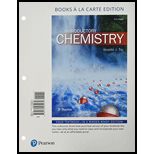
Introductory Chemistry, Books a la Carte Plus Mastering Chemistry with Pearson eText -- Access Card Package (6th Edition)
6th Edition
ISBN: 9780134557311
Author: Nivaldo J. Tro
Publisher: PEARSON
expand_more
expand_more
format_list_bulleted
Question
Chapter 15, Problem 59E
Interpretation Introduction
Interpretation:
The concentration of product, ICl is to be calculated with help of given concentration of reactants and equilibrium constant value.
Concept Introduction:
The expression of equilibrium constant is ratio of concentration of product to the concentration of reactant.
Keq= [product][reactant]
where, Keq is equilibrium constant, [product] is concentration of product and [reactant] is concentration of reactant.
Expert Solution & Answer
Want to see the full answer?
Check out a sample textbook solution
Students have asked these similar questions
For the Davies equation, both expressions are correct:
log Y₁ = -Az²
√i
- 0,31
1 +
√
k
log-
= Az
- 0,31
k
1 + √Ĩ
k
In Davies' equation log y₁ = log-
log y₁ = log | = -Az² + ✓//
k
A is a constant that always equals 1.02. Correct?
- 0,31
Indicate whether the equality is true Yi
How is it obtained?
k%
Chapter 15 Solutions
Introductory Chemistry, Books a la Carte Plus Mastering Chemistry with Pearson eText -- Access Card Package (6th Edition)
Ch. 15 - Q1. Which change is likely to increase the rate of...Ch. 15 - The equilibrium constants at a fixed temperature...Ch. 15 - Q3. The concentrations of A,B, and C for the...Ch. 15 - Q4. What is the correct expression for the...Ch. 15 - Q5. Consider the reaction between NO and to form...Ch. 15 - Q6. The equilibrium constant for this reaction is...Ch. 15 - Prob. 7SAQCh. 15 - Q8. The decomposition of is endothermic.
Which...Ch. 15 - Prob. 9SAQCh. 15 - Prob. 10SAQ
Ch. 15 - Prob. 1ECh. 15 - Prob. 2ECh. 15 - 3. Why do chemists seek to control reaction...Ch. 15 - How do most chemical reactions occur?Ch. 15 - What factors influence reaction rates? How?Ch. 15 - Prob. 6ECh. 15 - 7. What is dynamic chemical equilibrium?
Ch. 15 - Prob. 8ECh. 15 - Explain why the concentrations of reactants and...Ch. 15 - Devise your own analogylike the Narnia and Middle...Ch. 15 - Prob. 11ECh. 15 - Write the expression for the equilibrium constant...Ch. 15 - What does a small equilibrium constant tell you...Ch. 15 - Prob. 14ECh. 15 - Prob. 15ECh. 15 - Prob. 16ECh. 15 - Prob. 17ECh. 15 - Prob. 18ECh. 15 - What is the effect of decreasing the concentration...Ch. 15 - Prob. 20ECh. 15 - Prob. 21ECh. 15 - What is the effect of increasing the pressure of a...Ch. 15 - Prob. 23ECh. 15 - Prob. 24ECh. 15 - 25. What is the effect of decreasing the pressure...Ch. 15 - 26. What is the effect of increasing the...Ch. 15 - 27. What is the effect of increasing the...Ch. 15 - Prob. 28ECh. 15 - Prob. 29ECh. 15 - Prob. 30ECh. 15 - Prob. 31ECh. 15 - Prob. 32ECh. 15 - Prob. 33ECh. 15 - Prob. 34ECh. 15 - Does a catalyst affect the value of the...Ch. 15 - Prob. 36ECh. 15 - Prob. 37ECh. 15 - Prob. 38ECh. 15 - The body temperature of cold-blooded animals...Ch. 15 - The rate of a particular reaction doubles when the...Ch. 15 - Prob. 41ECh. 15 - Prob. 42ECh. 15 - Write an equilibrium expression for each chemical...Ch. 15 - Prob. 44ECh. 15 - Write an equilibrium expression for each chemical...Ch. 15 - Write an equilibrium expression for each chemical...Ch. 15 - Prob. 47ECh. 15 - Prob. 48ECh. 15 - 49. For each equilibrium constant, indicate if you...Ch. 15 - Prob. 50ECh. 15 - Prob. 51ECh. 15 - 52. Consider the reaction.
An equilibrium mixture...Ch. 15 - Consider the reaction. 2H2S(g)2H2(g)+S2(g) An...Ch. 15 - Prob. 54ECh. 15 - Prob. 55ECh. 15 - Consider the reaction. CaCO3(s)CaCO(s)+CO2(g) An...Ch. 15 - Prob. 57ECh. 15 - Prob. 58ECh. 15 - Prob. 59ECh. 15 - Prob. 60ECh. 15 - Prob. 61ECh. 15 - Prob. 62ECh. 15 - Consider this reaction at equilibrium....Ch. 15 - Prob. 64ECh. 15 - Consider this reaction at equilibrium....Ch. 15 - Prob. 66ECh. 15 - Consider the effect of a volume change on this...Ch. 15 - Prob. 68ECh. 15 - Prob. 69ECh. 15 - Prob. 70ECh. 15 - Prob. 71ECh. 15 - Prob. 72ECh. 15 - Prob. 73ECh. 15 - Prob. 74ECh. 15 - Coal, which is primarily carbon, can be converted...Ch. 15 - 76. Coal can be used to generate hydrogen gas (a...Ch. 15 - 77. For each compound, write an equation showing...Ch. 15 - Prob. 78ECh. 15 - Prob. 79ECh. 15 - Prob. 80ECh. 15 - A saturated solution of MgF2 has [Mg2+]=2.6104M...Ch. 15 - Prob. 82ECh. 15 - Prob. 83ECh. 15 - Prob. 84ECh. 15 - Prob. 85ECh. 15 - Prob. 86ECh. 15 - Prob. 87ECh. 15 - 88. Calculate the molar solubility of .
Ch. 15 - Prob. 89ECh. 15 - Prob. 90ECh. 15 - 91. Consider the reaction.
A solution is made...Ch. 15 - Prob. 92ECh. 15 - Prob. 93ECh. 15 - Prob. 94ECh. 15 - This reaction is exothermic....Ch. 15 - Prob. 96ECh. 15 - 97. Calculate the molar solubility of CuS. How...Ch. 15 - Calculate the molar solubility of FeCO3. How many...Ch. 15 - Prob. 99ECh. 15 - Prob. 100ECh. 15 - Prob. 101ECh. 15 - Prob. 102ECh. 15 - Consider the reaction: CaCO3CaO(s)+CO2(g) A sample...Ch. 15 - Prob. 104ECh. 15 - A 2.55-L solution is 0.115 M in Mg2+. If K2CO3 is...Ch. 15 - Prob. 106ECh. 15 - Prob. 107ECh. 15 - Prob. 108ECh. 15 - One of the main components of hard water is CaCO3....Ch. 15 - Prob. 110ECh. 15 - The reaction A(g)+B(g)2C(g) has an equilibrium...Ch. 15 - Describe three ways a reaction at equilibrium can...Ch. 15 - Solid CaCO3 decomposes into solid CaO and gaseous...
Knowledge Booster
Learn more about
Need a deep-dive on the concept behind this application? Look no further. Learn more about this topic, chemistry and related others by exploring similar questions and additional content below.Similar questions
- Indicate the relationship between the activity coefficient YA and the rate constant of a bimolecular reaction in solution k and the rate constant at infinite dilution ko.arrow_forwardDescribe the saline effect that occurs in solutions.arrow_forwardBriefly explain what the infinite dilution rate constant (k∞) consists of.arrow_forward
- The Davies equation corrects the Debye-Hückel limiting law for calculating the activity coefficient of an electrolyte in solution at relatively high concentrations. Mathematically, it is expressed as: log y₁ = -Az²? 1 + √Ĩ - 0,31) Is the formula correct?arrow_forwardDifferentiate between the concepts of "ionic salt effect" and "kinetic salt effect."arrow_forwardDifferentiate the concepts of “salino effect” and “salino kinetic effect”.arrow_forward
- Come and compare the Bronsted-Bjerrum calculation, the Debye and Hückel calculation, and the Davies calculation.arrow_forwardplz watch the youtube video (the title of this topic) by roxi H. she explains it step by step but i get the wrong answerarrow_forwardWriting the rate law implied by a simple mechanism To exit full screen, press and hold esc Suppose the decomposition of ozone proceeds by the following mechanism: step elementary reaction rate constant 1 →>> O3(9) O2(g) + O(g) k₁ 2 03(g) + O(g) → 202(g) k2 Suppose also k₁ »k2. That is, the first step is much faster than the second. Write the balanced chemical equation for the overall chemical reaction: Write the experimentally- observable rate law for the overall chemical reaction. ☐ rate = ☐ Note: your answer should not contain the concentrations of any intermediates. Express the rate constant k for the overall chemical reaction in terms of K1, K2, and (if necessary) the rate constants k-1 and K-2 for the reverse of the two elementary reactions in the mechanism. k = ☐ 000 18 ローロ Ar OOarrow_forward
- Deducing a rate law from the change in concentration over time To exit full screen, press and hold esc A chemistry graduate student is studying the rate of this reaction: H2CO3(aq) → H₂O(aq) +CO₂ (aq) - She fills a reaction vessel with H2CO3 and measures its concentration as the reaction proceeds: time (milliseconds) [H2CO3] 0 0.0500 M 10. 0.0266M 20. 0.0181 M 30. 0.0138M 40. 0.0111 M Use this data to answer the following questions. Write the rate law for this reaction. Calculate the value of the rate constant k. Round your answer to 2 significant digits. Also be sure your answer has the correct unit symbol. rate ☐ x10 k = Х 000 18 Ararrow_forwardWriting the rate law implied by a simple mechanism Suppose the formation of tert-butanol proceeds by the following mechanism: step elementary reaction 1 (CH3)3 CBr(aq) → (CH3)2 C* (aq) + Br (aq) 2 (CH3)2C (aq) + OH¯ (aq) → (CH3)2COH(aq) rate constant k₁ k₂ Suppose also k₁ »k2. That is, the first step is much faster than the second. Write the balanced chemical equation for the overall chemical reaction: Write the experimentally- observable rate law for the overall chemical reaction. Note: your answer should not contain the concentrations of any intermediates. rate = k ☐ Express the rate constant k for the overall chemical reaction in terms of K1, K2, and (if necessary) the rate constants k-1 and K-2 for the reverse of the two elementary reactions in the mechanism. k = ☐ □ ☑ G ? 00. 18 Ar Barrow_forwardDeducing a rate law from the change in concentration over time A chemistry graduate student is studying the rate of this reaction: 2SO3 (g) →>> 2SO2 (g) + O2(g) He fills a reaction vessel with SO3 and measures its concentration as the reaction proceeds: ? time (minutes) [SO3] 0 0.0200M 1.0 0.0105 M 2.0 0.00552M 3.0 0.00290M 4.0 0.00152M Use this data to answer the following questions. Write the rate law for this reaction. rate = k ☐ x10 Calculate the value of the rate constant k. Round your answer to 2 significant digits. Also be sure your answer has the correct unit symbol. k = ☐ Х 000 18 Ar BAarrow_forward
arrow_back_ios
SEE MORE QUESTIONS
arrow_forward_ios
Recommended textbooks for you
 Chemistry: Principles and PracticeChemistryISBN:9780534420123Author:Daniel L. Reger, Scott R. Goode, David W. Ball, Edward MercerPublisher:Cengage Learning
Chemistry: Principles and PracticeChemistryISBN:9780534420123Author:Daniel L. Reger, Scott R. Goode, David W. Ball, Edward MercerPublisher:Cengage Learning Chemistry: Principles and ReactionsChemistryISBN:9781305079373Author:William L. Masterton, Cecile N. HurleyPublisher:Cengage Learning
Chemistry: Principles and ReactionsChemistryISBN:9781305079373Author:William L. Masterton, Cecile N. HurleyPublisher:Cengage Learning Introductory Chemistry: A FoundationChemistryISBN:9781285199030Author:Steven S. Zumdahl, Donald J. DeCostePublisher:Cengage Learning
Introductory Chemistry: A FoundationChemistryISBN:9781285199030Author:Steven S. Zumdahl, Donald J. DeCostePublisher:Cengage Learning Chemistry: The Molecular ScienceChemistryISBN:9781285199047Author:John W. Moore, Conrad L. StanitskiPublisher:Cengage Learning
Chemistry: The Molecular ScienceChemistryISBN:9781285199047Author:John W. Moore, Conrad L. StanitskiPublisher:Cengage Learning Chemistry for Engineering StudentsChemistryISBN:9781337398909Author:Lawrence S. Brown, Tom HolmePublisher:Cengage Learning
Chemistry for Engineering StudentsChemistryISBN:9781337398909Author:Lawrence S. Brown, Tom HolmePublisher:Cengage Learning ChemistryChemistryISBN:9781305957404Author:Steven S. Zumdahl, Susan A. Zumdahl, Donald J. DeCostePublisher:Cengage Learning
ChemistryChemistryISBN:9781305957404Author:Steven S. Zumdahl, Susan A. Zumdahl, Donald J. DeCostePublisher:Cengage Learning

Chemistry: Principles and Practice
Chemistry
ISBN:9780534420123
Author:Daniel L. Reger, Scott R. Goode, David W. Ball, Edward Mercer
Publisher:Cengage Learning

Chemistry: Principles and Reactions
Chemistry
ISBN:9781305079373
Author:William L. Masterton, Cecile N. Hurley
Publisher:Cengage Learning

Introductory Chemistry: A Foundation
Chemistry
ISBN:9781285199030
Author:Steven S. Zumdahl, Donald J. DeCoste
Publisher:Cengage Learning

Chemistry: The Molecular Science
Chemistry
ISBN:9781285199047
Author:John W. Moore, Conrad L. Stanitski
Publisher:Cengage Learning

Chemistry for Engineering Students
Chemistry
ISBN:9781337398909
Author:Lawrence S. Brown, Tom Holme
Publisher:Cengage Learning

Chemistry
Chemistry
ISBN:9781305957404
Author:Steven S. Zumdahl, Susan A. Zumdahl, Donald J. DeCoste
Publisher:Cengage Learning
Chemical Equilibria and Reaction Quotients; Author: Professor Dave Explains;https://www.youtube.com/watch?v=1GiZzCzmO5Q;License: Standard YouTube License, CC-BY